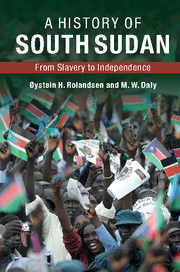
A history of South Sudan: from slavery to independence PDF
Preview A history of South Sudan: from slavery to independence
A HISTORY OF SOUTH SUDAN South Sudan is the world’s youngest independent country. Established in 2011 after two wars, South Sudan has since reverted to a state of devastating civil strife. This book is the first general history of the new country, from the arrival of Turco-Egyptian explorers in the upper Nile, the turbulence of the Mahdist revolu- tionaryperiod,thechaosofthe“ScrambleforAfrica,”duringwhich theSouthwaspreytoEuropeanandAfricanadventurersandempire builders,totheAnglo-Egyptiancolonialera.Specialattentionispaid to the period since Sudanese independence in 1956, when Southern disaffectiongrewintooutrightwar,fromthe1960sto1972andfrom 1983untiltheComprehensivePeaceof2005,andtothetransitionto SouthSudan’sindependence.Thebookconcludeswithcoverageof events since then, which, since December 2013, have assumed the character of civil war, and with insights into what the future might hold. o/ ystein h. rolandsen is a senior researcher at the Peace ResearchInstituteinOslo.Hehaswrittenextensivelyonthehistory andcurrentaffairsofthetwoSudans,aswellasontheeasternAfrican region. m. w. daly hasheldacademicpositionsintheUSA,theUK,and the Middle East. He is the author or coauthor of many works on Sudan,including(withP.M.Holt)AHistoryoftheSudan,2011,now in its sixth edition; Darfur’s Sorrow (Cambridge, 2010), now in its secondedition;andImperialSudan(Cambridge,1991). Published online by Cambridge University Press Published online by Cambridge University Press A HISTORY OF SOUTH SUDAN From Slavery to Independence ØYSTEIN H. ROLANDSEN M. W. DALY Published online by Cambridge University Press UniversityPrintingHouse,Cambridgecb28bs,UnitedKingdom CambridgeUniversityPressispartoftheUniversityofCambridge. ItfurtherstheUniversity’smissionbydisseminatingknowledgeinthepursuitof education,learningandresearchatthehighestinternationallevelsofexcellence. www.cambridge.org Informationonthistitle:www.cambridge.org ©ØysteinH.RolandsenandM.W.Daly2016 Thispublicationisincopyright.Subjecttostatutoryexception andtotheprovisionsofrelevantcollectivelicensingagreements, noreproductionofanypartmaytakeplacewithoutthewritten permissionofCambridgeUniversityPress. Firstpublished2016 PrintedintheUnitedStatesofAmericabySheridanBooks,Inc. AcatalogrecordforthispublicationisavailablefromtheBritishLibrary LibraryofCongressCataloginginPublicationdata Rolandsen,ØysteinH.,author. AhistoryofSouthSudanfromslaverytoindependence/ØysteinH.RolandsenandM.W.Daly. pages cm Includesbibliographicalreferencesandindex. isbn978-0-521-11631-2 1. SouthSudan–Politicsandgovernment. 2. SouthSudan–History. 3. Sudan–Politics andgovernment–1985– I. Daly,M.W.,author. II. Title. dt159.94.r65 2016 962.9–dc23 2015036420 isbn978-0-521-11631-2Hardback isbn978-0-521-13325-8Paperback CambridgeUniversityPresshasnoresponsibilityforthepersistenceoraccuracyof URLsforexternalorthird-partyinternetwebsitesreferredtointhispublication, anddoesnotguaranteethatanycontentonsuchwebsitesis,orwillremain, accurateorappropriate. Published online by Cambridge University Press Contents Preface pagevii Chronology ix ListofabbreviationsandArabicterms xvi Map xviii 1 Introduction:thelandandpeoplesoftheupperNile 1 2 Ivoryandslaves:thenineteenthcentury 10 3 ThesecondTurkiyya,1898–1953 32 4 Thecurseofcolonialcontinuity,1953–1963 65 5 Thefirstcivilwar,1963–1972 79 6 Regionalgovernment:fromonecivilwartoanother,1972–1983 93 7 Eclipsedbywar,1983–1991 105 8 Factionalpolitics,1991–2001 120 9 Makingunityimpossible,2002–2011 133 10 IndependentSouthSudan 151 Bibliographicalessay 160 Index 168 v Published online by Cambridge University Press Published online by Cambridge University Press Preface AHistoryofSouthSudanaddressesseveralaudiencesandawidevarietyof issues. We have chosen a conventional chronological approach, but a number of themes recur. Above all, we aim to illuminate two questions in the history of this new country: How did South Sudan become a politicalandadministrativeentity?AndwhydiditseparatefromSudan? Answeringthesequestionsrequiresanewlookatstandardversions,for the historiography of South Sudan reflects entrenched and often diame- trically opposed political views. Some nationalists’ mission to create a South Sudanese national identity has led to the invention of a “natural” and timeless political and cultural unit. But we know remarkably little aboutwhatmostpeopleeventodaythinkitmeanstobeSouthSudanese. Although this book is not a “history of an idea,” we examine some processes and events that contributed to shaping one. When South Sudanese voted, in January 2011, the proffered alternative to separation fromSudanwasconfederation andconsiderable autonomy:SouthSudan would be recognized as a political and administrative unit within Sudan. Yetthevotewentoverwhelminglyforindependence.Howdeep,andwith whatparticularramifications,wasthesentimentforseparation? After all, the history of South Sudan over the past two centuries is of steadily increasing interaction between its peoples and the outside world. And since the mid-twentieth century, South Sudanese have migrated (or fled)inmillionstoSudan,toneighboringcountries,andbeyond.Today, thereareSouthSudanesecommunitiesinmostcornersoftheworld.Some haveimpactedtheplacestowhichtheyhavemoved;manyhavereturned to South Sudan with new allies and ideas. Thus, patterns of interaction have varied considerably over time and from place to place. So also have South Sudanese responses, their motives, and the opportunities for exchangeandtransformationthatinteractionopenedup.Thisbookaims to present at least broad outlines of how these opportunities came about andtowhatusesSouthSudaneseputtheminpursuitoftheirowngoals. vii https://doi.org/10.1017/CBO9781139035538.001 Published online by Cambridge University Press viii Preface The term “South Sudan” has also become associated with war and humansuffering.Asyetanotherlarge-scaleconflictunfolds,itisimportant toemphasizethatthisisnotsenselessviolenceortheresultofincompetent politicians’ miscalculations, but the outcome of historical processes restrictedandshapedbyexternalandinstitutionalconditions.Thehistory of South Sudan is, in part, not only a product of violence, systems of oppression, and patterns of resistance but also a story of resilience and of theharnessingandmasteringofthegeographical,climatic,economic,and social contexts in which the people of this new country have found themselves. In a brief and sweeping book like this, abbreviation and omissions are inevitable. Our goal is to present a fair and balanced account of the interplay between the broader structural forces of history and the chief agentsofpoliticsandwarfare,thatis,governments,politicalparties,armed groups, community leaders, and businessmen, which drove South Sudan towardindependence.Bythis,wehopetocorrect(andindeedtoanalyze) the tendency in foreign source materials to depict outsiders as agents of change(howeverdefinedorcharacterized) andSouthSudanese aspassive (orirrational,orsubversive)receptors. Beyond what we can learn from oral tradition and archeology, South Sudan’sprecolonial history remains obscure. In consequence, the bookis dividedintotwomaineras:thatofcolonializationandcolonialism,andthe period from 1956 to 2011 whenSouth Sudan waspart of the independent Sudan. The years since South Sudan’s independence are briefly discussed in Chapter 10. The bibliographical essay at the end gives a rudimentary introduction to the historiography of South Sudan and lists references to pioneeringworkswhichofferin-depthanalysisandinformationconcern- ingaspectsofthiscountry’shistory.Butmuchstillremainstobedone,and if this book can inspire or provoke such endeavors we will consider our missionaccomplished. https://doi.org/10.1017/CBO9781139035538.001 Published online by Cambridge University Press Chronology 1839 First Egyptian expedition to the upper Nile. 1881–98 MahdistrevolutionendsTurco-Egyptian rule in northern Sudan (1885) and over- whelmsremainingoutpostsinsouth. 1899 Establishment of Anglo-Egyptian Condominium. 1930 End of “Nuer settlement” and armed SouthSudaneseresistance. January1930 “SouthernPolicy”adumbrated. 1946 “SouthernPolicy”officiallyrevoked. June1947 FirstJubaConference:SouthSudaneseto send representatives to National LegislativeAssembly. July1947 Striking workers in Juba demand pay equaltoNortherners’. February1953 Anglo-EgyptianAgreementstipulatesend ofcolonialrulewithinthreeyears. November1953 Firstnationalelection. October1954 “Sudanization” outcome announced; Southernerswinsixpostsofdistrictcom- missioner and assistant district commissioner. October1954 Second Juba conference: chiefs, civil ser- vants,andpoliticiansdemandfederalism. July1955 Nzaraprotestviolentlysuppressed. August18,1955 Torit Mutiny sparks weeks-long “Southern Disturbances”; subsequently putdownbySDF. ix https://doi.org/10.1017/CBO9781139035538.002 Published online by Cambridge University Press x Chronology January1956 RepublicofSudanestablished. 1957 Nationalizationofmissionaryschools. February1958 Secondnationalelection. November1958 Coup overthrows Sudanese government, beginningsixyearsofmilitaryrule. February1960 Southernschoolsclosedafterstudentpro- tests; grievances include replacement of SundaywithFridayasdayofrest. Early1962 Sudan African Closed Districts National Unionestablishedinexile. October1962 Southern students strike; thousands flee toneighboringcountries. November1962 “Regulations for Missionary Societies” restrict foreign missionaries; expulsions ensue. July/August1963 Anya-NyafoundedinKampala. September1963 Attacksin the Upper Nile and Equatoria sparkcivilwar. January1964 Anya-NyaattackWau;warengulfssouth- ernprovinces. February1964 Allforeignmissionariesexpelled. November1964 Military regime falls; Southerners join Transitional Government; Southern FrontemergesinKhartoum. March1965 Round Table Conference on South held inKhartoum. April1965 National elections return traditional par- tiestopower. July1965 Government soldiers carry out massacres inJubaandWau. May1969 Coup overthrows government; Col. Jaafar Nimeiri emerges as leader, rules until1985. February1972 SigningofAddisAbabapeaceaccord. October1973 First election to Southern Regional Assembly; Abel Alier becomes president ofHEC. 1974–7 Former Anya-Nya soldiers mutiny in Juba (1974, February 1977), Akobo (1975),andWau(1976). https://doi.org/10.1017/CBO9781139035538.002 Published online by Cambridge University Press
